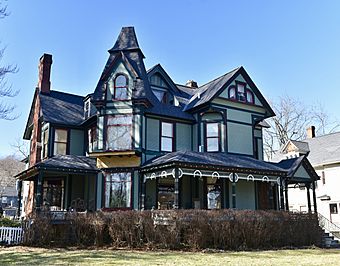Stuart Area Historic District facts for kids
|
Stuart Area Historic District
|
|

229 Stuart Avenue
|
|
| Location | Roughly bounded by Michigan Central RR, Douglas, Forbes, W. Main, North, Elm Sts., Kalamazoo and Grand Ave., Kalamazoo, Michigan |
|---|---|
| Area | 122 acres (49 ha) |
| Architectural style | Mixed (more Than 2 Styles From Different Periods), Late Victorian |
| MPS | Kalamazoo MRA |
| NRHP reference No. | 83000874 (original) 95000448 (increase) |
Quick facts for kids Significant dates |
|
| Added to NRHP | May 27, 1983 |
| Boundary increase | July 20, 1995 |
The Stuart Area Historic District is a special neighborhood in Kalamazoo, Michigan. It's a historic area mostly filled with homes. This district is famous because many of its buildings are old and important. It was added to the National Register of Historic Places in 1983. More parts were added in 1995.
Contents
A Look at the Past: How the Stuart Area Grew
The Stuart area started to grow in the 1840s and 1850s. Back then, it was like a quiet countryside area next to Kalamazoo. A nearby place called Mountain Home Cemetery was also planned around the same time.
Early Homes and Important People
A big step in the area's growth was when Charles E. Stuart built his house in 1854. He was an important person, a United States senator. Even with this new house, the area stayed pretty rural for a while.
The Horse-Car Line and New Growth
Things really changed in 1884 when a horse-car line was built. This was like an early public bus system, but pulled by horses! It made it much easier to get around. This new transport helped the neighborhood grow a lot.
A Fashionable Place to Live
From then on, the Stuart area became a very popular place to live. Many rich business owners and factory leaders built their large homes here. Three United States senators, including Charles E. Stuart, lived in this neighborhood. Kalamazoo was growing fast, and the beautiful houses showed how successful its citizens were.
Homes for Everyone
Not just the very rich moved in. Many middle-class families also found homes here. These were often skilled workers, professionals, and small business owners. They lived in smaller houses around the bigger mansions.
Keeping History Alive Today
As the 1900s began, Kalamazoo needed more housing. The Stuart neighborhood was easy to reach from downtown. This made it a good spot for new buildings. Some large old properties were even divided to make space for more homes. Today, the Stuart Area Historic District still looks much like it did long ago. It keeps its original historic feel.
What You'll See in the District Today
The Stuart Area Historic District has many historic buildings. The original part of the district has 322 homes. A later addition brought 53 more homes into the district.
Homes with Different Styles
Most of these buildings are homes for one family or multiple families. They were built in the late 1800s and early 1900s. You can see many different building styles here. Some popular styles include:
- Greek Revival
- Gothic Revival
- Italianate
- Eastlake
- Queen Anne
- Colonial Revival
Mountain Home Cemetery
The district also includes Mountain Home Cemetery. This cemetery was officially started in 1849. It is another important historic part of the area.



